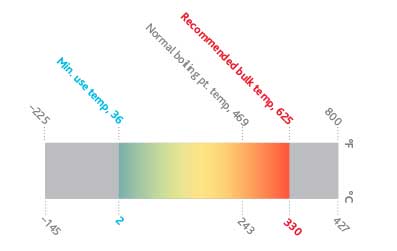How to Pick the Best Heat Transfer Fluid for Industrial Applications
How to Pick the Best Heat Transfer Fluid for Industrial Applications
Blog Article
Exactly How Warm Transfer Fluid Adds To Sustainable and Cost-Effective Operations
In the contemporary commercial landscape, the duty of warmth transfer liquids (HTFs) in promoting lasting and cost-efficient operations can not be overemphasized. These liquids are pivotal in enhancing thermal administration systems, therefore substantially boosting energy efficiency and minimizing functional prices. heat transfer fluid. The ecological advantages of innovative HTFs, with their high thermal security and low toxicity, are undeniable.
Comprehending Heat Transfer Liquids
In the realm of thermal management, heat transfer liquids (HTFs) serve as vital agents for moving thermal power from one area to one more. These fluids play a crucial function in different commercial applications, consisting of chemical processing, power generation, and Heating and cooling systems.
The composition of warmth transfer fluids can differ substantially, consisting of options such as mineral oils, artificial oils, glycols, and molten salts. Each type offers distinctive advantages, such as enhanced thermal security, low viscosity, and high boiling factors, which are selected based upon certain functional requirements. In addition, the option of HTF impacts not just the efficiency of warm transfer but additionally the durability and safety of the system in which it is utilized.
As markets remain to innovate, the advancement of advanced HTFs, identified by their improved thermal conductivity and minimized ecological influence, is vital for meeting the demands of contemporary thermal monitoring obstacles.

Enhancing Energy Performance

Improving power performance has actually come to be a paramount issue across different sectors, motivating a closer evaluation of heat transfer fluids' role in maximizing thermal administration systems. These liquids are integral to maintaining the desired temperature in procedures, therefore minimizing power waste and enhancing overall system effectiveness. By selecting an appropriate heat transfer fluid, industries can considerably improve their energy efficiency, bring about minimized power usage.

Advanced formulas of warmth transfer liquids have actually been established to withstand severe temperature levels while maintaining security and performance. These technologies prolong the operational life-span of the liquid, decreasing the frequency of replacements and energy-intensive upkeep activities. The usage of synthetic or bio-based liquids uses additional advantages in terms of decreased environmental influence, lining up with global sustainability objectives. Consequently, improving energy efficiency via optimum heat transfer liquid selection is not just a technical requirement but additionally an environmental important.
Decreasing Operational Prices
Operational prices are a significant consideration for markets looking for to keep affordable advantage, and the selection of heat transfer fluid plays a crucial role in expense monitoring. Selecting a proper warm transfer liquid can bring about significant cost savings by enhancing system effectiveness and lowering energy consumption. High-performance fluids reduce thermal deterioration, which subsequently lowers the frequency of fluid replacement and downtime related to maintenance, therefore decreasing see this page functional expenditures.
Moreover, heat transfer fluids with exceptional thermal stability and corrosion resistance expand the lifespan of equipment. This minimizes the demand for constant repair services and substitutes, which can be pricey and turbulent to operations. By spending in premium liquids, sectors can accomplish long-term decreases in maintenance prices and improve the integrity of their systems.
In addition, advanced heat transfer liquids commonly display reduced thickness at operating temperatures, which boosts pump effectiveness and reduces power use in fluid blood circulation. This optimization of power usage try this out directly converts right into decreased functional prices. In addition, several contemporary heat transfer liquids are crafted to run efficiently over a broad temperature level range, lowering the requirement for numerous fluid kinds, thereby simplifying inventory needs and reducing associated prices. These elements jointly add to more sustainable and cost-efficient operations.
Environmental Effect Decrease
The press in the direction of reducing ecological effect has acquired momentum in markets leveraging warm transfer liquids. Business are increasingly identifying the importance of minimizing ecological impacts by taking on lasting techniques. Warmth transfer liquids (HTFs) play a crucial function in this transition, offering opportunities to enhance power efficiency and reduce emissions. By picking HTFs with high thermal security and reduced toxicity, industries can ensure very little leakage and deterioration, thus minimizing hazardous environmental launches.
Furthermore, the use of innovative warmth transfer liquids adds to enhanced system performance, decreasing the general energy intake. This reduction not just leads to price savings but additionally reduces carbon dioxide exhausts, aiding in the battle against environment modification. Fluids that are naturally degradable and recyclable better improve sustainability initiatives, as they reduce waste and advertise circular economic situation practices.
In addition, incorporating HTFs right into closed-loop systems prevents fluid loss and contamination of the surrounding atmosphere. This approach makes certain that fluids are recycled, reducing the demand for brand-new resources and limiting waste generation. By welcoming these ecologically conscious methods, sectors can substantially lessen their ecological effect while keeping high operational efficiency, aligning with global sustainability objectives and governing requirements.
Selecting the Right HTF
Selecting the suitable warmth transfer liquid (HTF) resource is a vital step in progressing ecological sustainability within commercial procedures - heat transfer fluid. An excellent HTF must have a high thermal capability, low viscosity, and high thermal conductivity to guarantee effective heat transfer.
When choosing an HTF, it is important to consider its compatibility with system products to prevent corrosion and chemical reactions. This ensures longevity and reduces upkeep prices. Moreover, the fluid ought to be non-toxic and biodegradable, minimizing its eco-friendly impact and ensuring conformity with ecological policies. The lifecycle price of the HTF, including acquisition, operation, and disposal, must also be evaluated to make certain economic usefulness.
Conclusion

Report this page